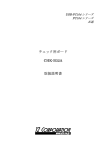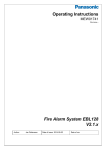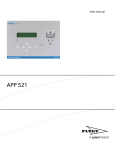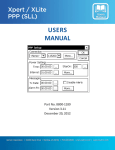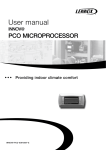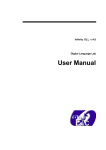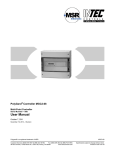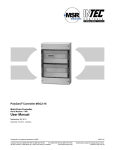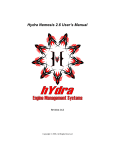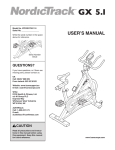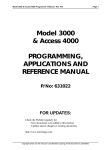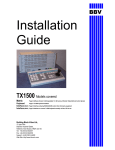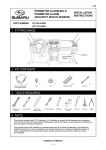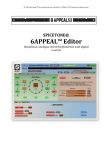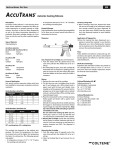Download Manuale utente microprocessore avanzato pCO ING
Transcript
LCA - LCW - LCR pCO ADVANCED MICROPROCESSOR USER MANUAL GB Index 1. 2 General description of the application ......................................................................... 4 1.1 Types of units controlled .................................................................................................................. 4 1.2 Maximum number of compressors................................................................................................... 4 1.3 Types of regulation .......................................................................................................................... 4 1.4 Condensation ................................................................................................................................... 4 1.5 Compressor operating turnover ....................................................................................................... 4 1.6 Defrosting modes (LCA-H model).................................................................................................... 4 1.7 Safety devices on each cooling circuit............................................................................................. 4 1.8 System safety features .................................................................................................................... 4 1.9 Optional accessories........................................................................................................................ 4 Regulation logic........................................................................................................... 5 2.1 2.1.1 2.1.2 2.1.3 2.2 2.2.1 2.2.2 2.2.3 2.2.4 2.2.5 2.3 2.3.1 2.3.2 2.3.3 3 Inlet temperature regulation ............................................................................................................. 5 PROPORTIONAL regulation ....................................................................................................... 5 PROPORTIONAL + INTEGRAL Regulation................................................................................ 5 Setpoint........................................................................................................................................ 5 Compressor times and configuration ............................................................................................... 6 Compressor operation turnover................................................................................................... 6 Minimum compressor “ON” time.................................................................................................. 6 Minimum compressor “OFF” time................................................................................................ 7 Delay between two start-up requests .......................................................................................... 7 Delay between two successive start-ups of the same compressor............................................. 7 Condensation Control ...................................................................................................................... 8 Settings........................................................................................................................................ 8 High pressure alarm .................................................................................................................. 10 Prevent function......................................................................................................................... 10 2.4 Defrost control................................................................................................................................ 10 2.5 Antifreeze regulation ...................................................................................................................... 11 Start-up and configuration ......................................................................................... 13 3.1 Terminal with keyboard and display .............................................................................................. 13 3.2 Display ........................................................................................................................................... 13 3.2.1 Moving around inside the masks ............................................................................................... 13 3.3 Keyboard........................................................................................................................................ 14 3.4 Starting up the unit for the first time ............................................................................................... 15 RG66001134 - Rev.00 2 3.5 4 5 Alarm management ................................................................................................... 16 4.1 Main alarm table ............................................................................................................................ 16 4.2 Alarm history .................................................................................................................................. 17 Menu tree structure ................................................................................................... 18 5.1.1 5.1.2 5.1.3 5.1.4 5.1.5 5.1.6 5.1.7 5.1.8 6 Main menu ................................................................................................................................. 18 Maintenance menu .................................................................................................................... 18 I/O Menu .................................................................................................................................... 20 Clock menu................................................................................................................................ 21 Setpoint Menu............................................................................................................................ 21 User menu ................................................................................................................................. 21 Manufacturer menu.................................................................................................................... 23 Alarm menu ............................................................................................................................... 24 Application setting parameters .................................................................................. 26 6.1 7 General description of menus ........................................................................................................ 15 Table of default settings................................................................................................................. 26 Architecture of the control system ............................................................................. 28 7.1 Microprocessor layout.................................................................................................................... 28 7.2 Description of inputs and outputs................................................................................................... 29 7.3 Optional boards.............................................................................................................................. 31 7.3.1 7.3.2 7.4 RS485 serial board for supervisory function ............................................................................. 31 Clock board................................................................................................................................ 31 Technical data................................................................................................................................ 32 RG66001134 - Rev.00 3 1. General description of the application The operation of LCA and LCA-H units (heat pump model) is managed by application software installed in the controller on the unit. The main features of the application program are described below. 1.1 Types of units controlled The software is designed to control air/water chiller units (LCA model), also models with operation as a heat pump (LCA-H model). 1.2 Maximum number of compressors From 1 to 4 hermetic scroll compressors, up to 2 cooling circuits. 1.3 Types of regulation Proportional regulation or proportional regulation with integral action on the evaporator input temperature. Possibility of adjusting the setpoint remotely. 1.4 Condensation Condensation can be carried out in the following modes: • on/off based on compressor operation (without pressure transducers); • on/off or modulating based on the pressure transducer reading (when high pressure transducers are enabled); 1.5 Compressor operating turnover Turnover of all compressors according to a FIFO logic. Selection of balanced turnover of all compressors according to a FIFO logic. 1.6 Defrosting modes (LCA-H model) Defrosting can be simultaneous or separated among the circuits. 1.7 Safety devices on each cooling circuit • • • High pressure (pressure switch). Low pressure (pressure switch). Compressor thermal switch. 1.8 System safety features • • • • • Serious alarm (shuts the whole unit down) Evaporator flow switch (shuts the whole unit down). Pump thermal switch Condensation fan thermal switch Remote on/off input without alarm signalling. 1.9 Optional accessories • • Supervision by means of RS485 serial board. Alarm history building with clock board. RG66001134 - Rev.00 4 2 Regulation logic 2.1 Inlet temperature regulation Inputs used: • Evaporator inlet water temperature Parameters used: • Regulation setpoint • Proportional band for input temperature regulation. • Type of regulation (proportional or proportional + integral) • Integration time (if proportional + integral regulation is enabled) Outputs used: • Compressor On/Off Regulation diagram with two compressors: 2 = C1 e C2 On 1 = C1 On e C2 Off 2 1 0 = C1 e C2 Off 0 Set1-Diff1 Set2-Diff2 Set1 Set2 Inlet water T Figure 0: Regulation diagram with two compressors 2.1.1 PROPORTIONAL regulation On the basis of the setpoint entered from the mask (ref. mask M_SETPOINT5, page 21 ), if the secondary setpoint or the remote setpoint is active, a proportional band is calculated with a width equal to the differential set from the mask (ref. mask M_USER25, page 21). Inside this band the positions of the device regulation steps are calculated according to the number of compressors. 2.1.2 PROPORTIONAL + INTEGRAL Regulation Proportional + integral regulation uses the same parameters as simple proportional regulation; it calculates the steps at which the devices are cut in on the basis of the setpoint, the differential and the integration time set from the mask (ref. mask M_USER20, page 21). The integral action is doubled if the conditions have not changed after the time set. 2.1.3 Setpoint Main Setpoint From the mask M_SETPOINT15 (see page and winter (LCA-H) operating modes. ) it is possible to set the main setpoint for the summer (LCA) Secondary Setpoint From the mask M_MANUF28 (see page 23) it is possible to select the ID 14 digital input configuration for the management of serious alarms or the secondary setpoint. If secondary setpoint management is selected, the M_SETPOINT10 (see page 21) is enabled for the setting of the summer and winter setpoints controlled by the digital input. RG66001134 - Rev.00 5 With the digital input open, the setpoint entered from the M_SETPOINT5 mask (see page 21) will be used; with the digital input closed, the secondary setpoint will be used. An "R" will appear in the upper right corner of the setpoint masks to indicate the activation of the secondary setpoint. Remote Setpoint From the M_USER24 mask (see page 21) it is possible to enable the remote setpoint function that uses an analog input. The signal will be converted between the minimum and maximum values set from the mask. The read value will then be added to the setpoint value resulting from the secondary setpoint management. 2.2 Compressor times and configuration The unit enables the control of hermetic scroll compressors. Mask M_MANUF20 (see 5.1.7 Manufacturer menu page 23) is used for configuration purposes; from the mask it is necessary to set the number of compressors per circuit and the number of circuits. Most of the operations performed by the pCO1 are conditioned by programmable delays. Some of them serve to delay the triggering of some alarms or to assure the proper functioning of the compressors, thereby lengthening their lives and guaranteeing system stability. 2.2.1 Compressor operation turnover The compressor operation turnover makes it possible to balance the number of hours of operation and the number of starts-stops of the various compressors. The turnover is carried out according to a FIFO logic, meaning that the first compressor to start will also be the first to stop. During the initial start-up period this behaviour may result in big differences between the operating hours of the compressors. However, at full capacity operation the number of hours will be very similar. Management without FIFO turnover (with four compressors): • Start-up: C1,C2,C3,C4. • Stop: C4,C3,C2,C1. Management with FIFO turnover (with four compressors): • Start-up: C1,C2,C3,C4. • Stop: C1,C2,C3,C4. If the turnover function is enabled it is possible to select the balanced turnover , which always follows a FIFO logic, i.e. the odd devices are activated first and then the even ones: • Start-up: C1, C3, C2, C4. • Stop: C1, C3, C2, C4. 2.2.2 Minimum compressor “ON” time (ref. mask M_MANUF40, 5.1.7 see Manufacturer menu , page 23) This determines the minimum time (in seconds) the devices must continue running: therefore, once activated they must stay on for the set length of time. RG66001134 - Rev.00 6 ON Start-up Request OFF ON Device OFF Figure 0: Minimum compressor on time 2.2.3 Minimum compressor “OFF” time (ref. mask M_MANUF40, 5.1.7 see Manufacturer menu , page 23) This determines the minimum time the devices must remain off. After they are shut off, the compressors cannot start up again until the set time has elapsed. ON Shut-off Request OFF ON Device OFF Figure 0: Minimum compressor off time 2.2.4 Delay between two start-up requests (ref. mask M_MANUF45, 5.1.7 see Manufacturer menu , page 23) This determines the minimum time that must elapse between two device starts irrespective of the read measurement or setpoint. This parameter makes it possible to limit the number of starts per hour. If, for instance, the maximum allowed number of starts per hour is 10, setting a value of 360 seconds will ensure that this limit is complied with. ON Device 1 Start-up OFF ON Device 2 Start-up OFF Figure 0: Delay between two start-up requests 2.2.5 Delay between two successive start-ups of the same compressor (ref. mask M_MANUF45, 5.1.7 see Manufacturer menu , page 23) This establishes the minimum time that must elapse between two starts of the same device, irrespective of the read measurement or the setpoint. This parameter makes it possible to limit the number of starts per hour. If, for instance, the maximum allowed number of starts per hour is 10, setting a value of 360 seconds will ensure that this limit is complied with. RG66001134 - Rev.00 7 ON Start-up Request OFF ON Device OFF Figure 0: Delay between two successive start-ups of the same compressor 2.3 Condensation Control Condensation can be regulated according to the following modes • on/off based on compressor operation (without pressure transducers); • on/off or modulating based on the pressure transducer reading (when high pressure transducers are enabled); Inputs used: • High pressure probe of first circuit (B5 analog input) • High pressure probe of second circuit (B6 analog input) Parameters used: • Condensation control selection: none/pressure • Number of fans • Type of condensation coil (Single / Separate) • Condensation Setpoint • Condensation Differential • Enabling of prevent function • Prevent Setpoint • Prevent Differential • Delay in device reactivation after triggering of prevent function • Output voltage relative to minimum inverter speed • Output voltage relative to maximum inverter speed • Inverter speed-up time Outputs used: • Fans (NO9 digital output) • Fan speed regulation (Y1 analog output) 2.3.1 Settings For condensation it is necessary to set: • the type of regulation by means of the “Abilit.“ (Enable) code in the M_MANUF50 mask (see page 23). The selection is made between NO / TEMPERATURE for choosing regulation either on the basis of the compressor status or on the basis of the values read by the pressure transducers; • the type of devices used by specifying the “Tipo” (Type) code in the M_MANUF50 mask ( see page 23). The selection is made between INVERTER / GRADINI (STEPS) for choosing either the modulating or the ON/OFF type regulation; • the number of fans connected if step regulation is selected, by entering a value for “N. Ventilatori” (No. of fans ) in the M_MANUF55 mask (see page 23); • the type of condenser by means of the “Condensatore” (Condenser) code in the M_MANUF55 mask (see page 23). The selection is made between SINGLE / SEPARATE; • the condensation setpoint and the differential, to be entered in the M_MANUF60 mask (see page 23). The setting generates a proportional band (setpoint / setpoint + differential) from which it calculates the position of the various fan activation steps or the modulating output value according to the selection made; • the minimum and maximum speeds of the inverter by specifying the “Max.velocità” (Max. Speed), ”Min.velocità” (Min. Speed) codes in the M_MANUF70 mask (see page 23); the proportional action of the modulating output is calculated within the range of these values; RG66001134 - Rev.00 8 • • • • the minimum operating time of the inverter by specifying the “Tempo min ON" (Min. ON Time) code on the M_MANUF70 mask (see page 23); enabling of the prevent function by means of the “Abilit." Prevenzione ALTA PRESSIONE (“Enable” HIGH PRESSURE prevention) code in the M_MANUF80 mask (see page 23). The prevent function will be executed according to the modes specified below in this section; the prevent setpoint and differential (ref. M_MANUF80 mask , see page 23); the delay in compressor restarts after triggering of the prevent function (ref. M_MANUF81 mask page 23); Condensation on/off based on compressor operation If NO is selected in the M_MANUF50 mask (see page 23) the fans’ operation will depend only on the operation of the compressors. Condensation on/off based on pressure sensor If PRESSURE is selected in the M_MANUF50 mask (see page 23), the fans’ operation will depend only on the pressure read by the pressure sensors, according to the selected setpoint and differential band. With pressure values lower or equal to the setpoint all fans will be turned off; with pressure values higher than the setpoint + differential band, all fans will be turned on. It will be possible to select the condensation function either with a single coil or separate coil. In the case of single coil condensation, the fans will be controlled by the highest pressure; with separate coil condensation each pressure sensor will control its respective fan. Modulating condensation based on pressure sensor If this type of condensation is chosen, the fans will be controlled in a manner proportional to the readings of the pressure sensor. It will be possible to select the condensation function either with a single or separate coil. In the case of a single coil, the inverter will be controlled by the highest pressure; with a separate coil each pressure sensor will control its respective inverter. The graph below shows fan operation after the setpoint and the differential band have been set. Fan power supply 10V 0V Differential band Setpoint Setpoint + diff. High pressure probe (bar) Figure 0: Modulating condensation based on pressure sensor If the minimum fan speed is assigned to a power supply value higher than 0V (the graph shows a case where the minimum speed has been assigned to 3V) a 1 bar hysteresis (default) is applied in order to avoid repeated start-ups and stops. RG66001134 - Rev.00 9 Fan power supply 10V 3V 0V Differential band Setpoint -1 Setpoint Setpoint + diff. High pressure probe (bar) Figure 0: Modulating condensation with 1 bar Hysteresis 2.3.2 High pressure alarm If the pressure value exceeds the high pressure alarm setpoint selected in the M_MANUF85 mask (see page 23) an alarm will be signalled and the circuit concerned will be deactivated. The alarm will turn off when the pressure drops below the setpoint – differential value. 2.3.3 Prevent function Selecting this function requires access to a factory-set password. It serves to prevent circuits from being blocked due to the triggering of the high pressure alarm. It can be set only on units having two compressors per circuit. Setpoint and differential values must be selected from the M_MANUF80 mask (see page 23 ). The prevent function shuts off the compressors, thereby dividing the power supplied to the cooling circuit. When the condensation pressure exceeds the prevent function activation value (setpoint), the function is triggered and remains active until the value detected goes below the prevent function deactivation value (setpoint – differential). At this point a delay is activated (settable from the M_MANUF81 mask on page 23) which lengthens the prevent action, thus delaying any restart of the compressors. 2.4 Defrost control Inputs used: • High pressure probe of first circuit (B5 analog input) • High pressure probe of second circuit (B6 analog input) Parameters used: • Inputs used for defrosting • Defrosting modes (simultaneous / separate) • Start defrost setting • End defrost setting • Defrost delay time • Maximum defrost time • Drip time • Reverse cycle with compressors off (No / Input / Output / Input-Output) Outputs used: • Compressor 1 • Compressor 2 • Compressor 3 • Compressor 4 • Reversing solenoid valve – cycle 1 • Reversing solenoid valve – cycle 2 • Fans RG66001134 - Rev.00 10 The defrosting function requires the setting of some parameters protected by a factory-set password (ref. M_MANUF130 mask page 23), i.e.: • PRESSURE defrosting probe; • Defrosting mode (SIMULTANEOUS / SEPARATE); • Cooling cycle reverse with compressors turned off (NO / INPUT /OUTPUT / INPUT-OUTPUT); as well as some parameters protected by a user password (ref. M_USER50 / 55 mask – see page 23), i.e.: • start/end defrost threshold; • defrost activation delay time; • maximum defrost time; • drip time at the end of defrosting cycle; Defrosting of one circuit under pressure control: The defrosting cycle starts when the coil temperature/pressure remains below the start defrost threshold for a total time (t1+t2+t3) equal to the defrost delay time and if at least one compressor of the circuit concerned is on. • compressors are or are not turned off according to the selection made from the mask and the cooling cycle is reversed by means of the 4-way valves. • the fans are forced into the OFF mode. The circuit terminates the defrosting cycle when the threshold is exceeded, i.e. when the temperature/pressure value exceeds the end defrost setpoint or when the maximum time set from the mask has elapsed if the temperature/pressure value has not exceeded the end defrost setpoint. Pressure Fine Set Set t1 t2 t3 Defrosting cycle Time Figure 0: Defrosting cycle Simultaneous defrosting mode Even if only one circuit requires defrosting, all circuits are forced into the defrosting mode. Circuits not requiring defrosting (temperature/pressure higher than the end defrost threshold) stop and remain on standby. As soon as the defrosting cycle has terminated, all the compressors can start up again in the heat pump mode. Separate defrosting mode In this defrosting mode each cooling circuit undergoes a defrosting cycle separately. The first circuit requiring defrosting starts a defrosting cycle, whereas the other circuits remain on standby until the first circuit has completed its defrosting cycle, even if they too require defrosting. When the defrosting cycle of the first circuit is finished, the following circuit will be defrosted, while the other circuits wait their turn. 2.5 Antifreeze regulation Inputs used • Evaporator outlet water temperature probe. Parameters used: • Enabling of outlet line probe; • Antifreeze alarm setpoint; RG66001134 - Rev.00 11 • Antifreeze alarm differential; Outputs used: • Antifreeze alarm; Each pCO1 unit can manage antifreeze regulation provided that the outlet temperature probe is connected and enabled. Alarm status Alarm ON Alarm OFF Antifreeze differential Evaporator outlet temperature Antifreeze Setpoint + diff. Band setpoint Figure 0: Antifreeze regulation RG66001134 - Rev.00 12 3 Start-up and configuration 3.1 Terminal with keyboard and display Figure 0: Terminal The user terminal is shown in the picture. It consists of a 4 line x 20 column LCD, keyboard and LEDs controlled by a microprocessor: from the terminal the user can set the control parameters (setpoint, differential band, alarm thresholds, etc.) and perform fundamental operations. The following main operations can be performed via the terminal: • initial machine configuration; • modification of main operating parameters; • display of machine status and of all measured data; • display of the alarms detected and a 'buzzer' (that can be disabled); The terminal and the pCO1 controller are connected via a 6-way telephone cable. This connection is not essential for standard controller operation. 3.2 Display The display used is of the 4 line x 20 column LCD type. The data and information regarding operation alternate as successive windows called masks. It is possible to move around inside the masks using the terminal keys as described below: 3.2.1 Moving around inside the masks ╔════════════════════╗ ║x Line0 ║ ║Home Line1 ║ ║ Line2 ║ ║ Line3 ║ ╚════════════════════╝ If the cursor is positioned in the top left-hand corner (Home) pressing the keys allows the user to access the successive masks associated with the selected branch. If a mask includes fields for setting values, pressing the ENTER key will cause the cursor to move into these fields. Once a parameter setting keys. Once the field is reached it is possible to change its value, within the set limits, by pressing the desired value has been set, pressing the ENTER key again will store it in the memory. RG66001134 - Rev.00 13 3.3 Keyboard Key 1 ↓ Key 2 ↓ Key 3 ↓ Key 4 ↓ ↑ Key 8 ↑ Key 9 ↑ Key 10 ↑ Key 11 Key 5 ↓ ↑ Key 12 Key 6 ↓ ↑ Key 13 ↑ Key 14 Key 7 ↓ ↑ Key 15: Key 1: Accesses the mask displaying the fundamental machine data and status. Key 2: Accesses device maintenance data (hours of service of a device and hour meter reset, alarm history, manual operating procedure). Key 3: Function not active. Key 4: Accesses the masks displaying digital and analog input/output statuses. Key 5: Accesses the clock programming mask (if a clock board is included). Key 6: Accesses the setpoint display / setting masks. Key 7: Accesses the user parameter programming masks (thresholds, delays etc.). Key 1 + Key 7: By pressing these keys at the same time the user accesses the machine configuration (number of devices connected to the pCO1, programming of the full scale values, etc.). Key 8: Displays data concerning the software used. Key 9: For selecting the winter mode (LCA-H model, not available on the LCA model). Key 10: For selecting the summer mode (LCA-H model, this mode is always active on the LCA model). Key 11: This key allows the unit to be switched on and off. The green LED illuminating the key indicates the unit status. Key 12: This key is used for displaying alarms, resetting them manually and silencing the buzzer. If the key is lit (red LED) it means that at least one alarm has been detected. Pressing the key once will silence the buzzer and cause a mask to appear which describes the alarm that is active. Pressing a second time will reset the alarm signalling function. Key 13: this key enables the setting of control parameters as well as movement from one mask to another (not backlit). Key 14: this key enables the setting of control parameters as well as movement from one mask to another (not backlit). Key 15: used for moving the cursor inside the masks and saving parameter settings. The key is constantly backlit (yellow light) to indicate that the power supply is on. NOTE: The LEDs alongside each key come on when the respective function is activated. RG66001134 - Rev.00 14 3.4 Starting up the unit for the first time When the microprocessor is connected to the power supply, the main menu will be displayed (M_Main). It contains the following information: • • • • M_Main ╔════════════════════╗ ║00 00 00 00 00║ ║Inlet water 00.0°C║ ║Outlet water 00.0°C║ ║ON ║ ╚════════════════════╝ current date and time; evaporator inlet water temperature; evaporator outlet water temperature; unit status; 3.5 General description of menus General description of the menus featured in the application; all the masks are shown and described in the chapter 5 Main menu The main menu is displayed when the unit is started up and consists of the two masks described in the section 3.4 Starting up the unit for the first time Maintenance menu The maintenance menu can be accessed by pressing key 2. It shows the compressor and pump hour meters as well as the alarm history if a clock board has been installed. If the maintenance password is entered (given to maintenance personnel directly by Galletti S.p.a) it will be possible to set the device hour meter alarm thresholds, clear the hour meter, set the probes, set the pump type and turnover time and enable the buzzer. I/O Menu The I/O menu can be accessed by pressing key 4 and shows the system’s inputs and outputs. Clock menu The clock menu can be accessed by pressing key 5 and contains the time and date configuration. Setpoint Menu The Setpoint menu can be accessed by pressing key 6 and allows management of fixed and variable setpoints. User menu The User menu can be accessed by pressing key 7 and contains the configuration of user parameters. It is password protected. Manufacturer menu The Manufacturer menu can be accessed by pressing key 1 + key 7 together and contains the configuration of factory-set parameters. It is password protected. Alarm menu The Alarm menu can be accessed by pressing key 12 and gives information about the alarms that have been triggered. RG66001134 - Rev.00 15 4 Alarm management The alarms are divided into three categories: 1. Warnings only (with display of warning message and buzzer or display of warning message, buzzer and alarm relay) 2. Circuit alarms (with deactivation of the circuit concerned, display of alarm message, buzzer and alarm relay); 3. Serious alarms (with shut down of the whole system, display of alarm message, buzzer and alarm relay). Warnings • Unit maintenance warning; • Compressor maintenance warning; • Clock board failure or disconnection; Circuit alarms • High pressure/pressure switch alarm: immediate shut down of the compressor and manual resetting • Low pressure alarm with automatic/manual resetting (see description of its operation) • Compressor thermal switch alarm with immediate shut down of the compressor and manual resetting; • Fan thermal switch alarm, with fan stop and manual resetting. Serious Alarms • lack of water flow digital input alarm, delayed at start-up and at full capacity operation; • evaporator antifreeze alarm, evaporator outlet probe function with activation setpoint and reset differential, with manual resetting • serious alarm from digital input. Immediate shut down of the unit and manual resetting. The alarms are reset manually by pressing the alarm key twice. 4.1 Main alarm table Alarm Description Serious alarm Antifreeze alarm Thermal switch-Pump 1 Thermal switch-Pump 2 Evaporator flow switch Low pressure Press. switch C1 Low pressure Press. switch C2 High pressure Press. switch C1 High pressure Press. switch C2 Fan thermal switch 1 Fan thermal switch 2 Probe failure B1 Probe failure B2 Probe failure B3 Probe failure B4 Probe failure B5 RG66001134 - Rev.00 Compr. Off * * * * * Fan Off * * * * * Pump Off * Reset Auto/Man Man. Man. Man. Man. Man. No No No No settable * Man. settable * Man. no Auto. Auto. Auto. Auto. Auto. 60 sec. 60 sec. 60 sec. 60 sec. 60 sec. * * 16 System Off * * * * Delay Probe failure B6 Maint. Pump 1 Maint. Pump 2 Maint. Compressor 1 Maint. Compressor 2 Maint. Compressor 3 Maint. Compressor 4 Phase direction * * * * Auto. Man. Man. Man. Man. Man. Man. Man. 60 sec. - 4.2 Alarm history The unit has an alarm history function. To activate this function it is necessary to install the optional clock board, provided with 32k memory, and enable its use from the mask (ref. mask M_MANUF27 5.1.7 see Manufacturer menu , page 23) Alarms are memorised according to priorities decided at the programming stage. Each alarm has been attributed a priority code (the lower the code, the higher the priority); in this way if two alarms with different priorities are tripped at the same time, only the alarm with the lower code is stored (ref. 5.1.8 Alarm menu ). In addition to the alarm code, the function stores the date and time, evaporator inlet and outlet temperatures, setpoint and band used at the moment the alarm is activated (ref. mask M_MAINT17 see page ). M_Maint17 ╔════════════════════╗ ║History alarm 0000║ ║AL000 00:00 00/00/00║ ║Set 00.0 Band 00.0║ ║T.In 00.0 T.out 00.0║ ╚════════════════════╝ A maximum number of 1600 alarms can be stored. After this limit is reached memorisation will again start from the beginning, i.e. the oldest alarm will be overwritten with the new data. RG66001134 - Rev.00 17 5 Menu tree structure 5.1.1 Main menu M_Main ╔════════════════════╗ ║00 00 00 00 00║ ║Inlet water 00.0°C║ ║Outlet water 00.0°C║ ║ON ║ ╚════════════════════╝ The main information regarding the chiller’s operation is displayed here. If the (optional) clock board has been installed, the current date and time will also be displayed 5.1.2 Maintenance menu M_Maint5 ╔════════════════════╗ ║Pump 1 ║ ║hour meters ║ ║ ║ ║Hours 000000║ ╚════════════════════╝ M_Maint6 ╔════════════════════╗ ║Pump 2 ║ ║hour meters ║ ║ ║ ║Hours 000000║ ╚════════════════════╝ Pressing the MAINTENANCE key provides access to these masks, which display the number of hours of work performed by each device. These values will be stored in the flash memory of the pCO1 board; data are recorded at three-hour intervals. This function is provided whether or not a clock board is installed on the pCO1. If the number of working hours of a device equals the set threshold, the relative alarm is triggered. ║ M_Maint10 ╔════════════════════╗ ║Hour meters ║ ║ ║ ║Compressor 1 000000║ ║Compressor 2 000000║ ╚════════════════════╝ M_Maint15 ╔════════════════════╗ ║Hour meters ║ ║ ║ ║Compressor 3 000000║ ║Compressor 4 000000║ ╚════════════════════╝ M_Maint17 ╔════════════════════╗ ║History alarm 0000║ ║AL000 00:00 00/00/00║ ║Set 00.0 Band 00.0║ ║T.In 00.0 T.out 00.0║ ╚════════════════════╝ M_Pw_Maint ╔════════════════════╗ ║Insert ║ ║maintenance password║ ║ ║ ║ 0000 ║ ╚════════════════════╝ M_Maint20 ╔════════════════════╗ ║Pump 1 hour meter ║ ║ ║ ║threshold 000x1000║ ║Req.reset N 000000║ ╚════════════════════╝ RG66001134 - Rev.00 This is the alarm history mask. The maintenance password is required for viewing the following masks. The password is only available on request. In these masks it is possible to modify the value of the device maintenance alarm threshold and reset the hour meter of each device after it has undergone maintenance 18 M_Maint21 ╔════════════════════╗ ║Pump 2 hour meter ║ ║ ║ ║threshold 000x1000║ ║Req.reset N 000000║ ╚════════════════════╝ M_Maint25 ╔════════════════════╗ ║Compressor 1 ║ ║hour meter ║ ║Threshold 000x1000║ ║Req.reset N 000000║ ╚════════════════════╝ M_Maint30 ╔════════════════════╗ ║Compressor 2 ║ ║hour meter ║ ║Threshold 000x1000║ ║Req.reset N 000000║ ╚════════════════════╝ M_Maint35 ╔════════════════════╗ ║Compressor 3 ║ ║hour meter ║ ║Threshold 000x1000║ ║Req.reset N 000000║ ╚════════════════════╝ M_Maint40 ╔════════════════════╗ ║Compressor 4 ║ ║hour meter ║ ║Threshold 000x1000║ ║Req.reset N 000000║ ╚════════════════════╝ M_Maint45 ╔════════════════════╗ ║Filters config. ║ ║Enable N ║ ║Anal. delay time 0s║ ║Dig. delay time 0s║ ╚════════════════════╝ M_Maint50 ╔════════════════════╗ ║Inputs probes offset║ ║B1: 0.0 B2: 0.0 ║ ║B3: 0.0 B4: 0.0 ║ ║B5: 0.0 B6: 0.0 ║ ╚════════════════════╝ From this mask it is possible to enable the software filters applied on analog inputs. The detected input value is transmitted to the control if it maintains the value for a time equal to or greater than the time set. Here it is possible to set probe offset values to be added to or subtracted from readings. (See 17 flap for installation of clock board (optional) . ) M_Maint60 ╔════════════════════╗ ║Pump sequence type ║ ║ ║ ║ ║ ║AUTOMATIC ║ ╚════════════════════╝ M_Maint65 ╔════════════════════╗ ║Pump sequence time ║ ║ ║ ║ ║ ║ 000 hours║ ╚════════════════════╝ RG66001134 - Rev.00 19 M_Maint70 ╔════════════════════╗ ║Pump sequence ║ ║selection ║ ║ ║ ║SEQUENCE 1 ║ ╚════════════════════╝ M_Maint75 ╔════════════════════╗ ║Erase historical ║ ║memory board ║ ║ N ║ ║ ║ ╚════════════════════╝ This mask only appears if the clock board has been configured and the unit is off. Selecting S activates the procedure of erasing all the historical data. During this operation, a stand-by message will appear on the last line of the mask and no other operation will be possible until erasure is complete. M_Maint100 ╔════════════════════╗ ║Insert another ║ ║maintenance ║ ║password ║ ║ 0000 ║ ╚════════════════════╝ 5.1.3 I/O Menu This set of masks provides a complete display of the statuses of the analog and digital inputs and outputs connected to the microprocessor. M_InOut10 ╔════════════════════╗ ║Digital inputs ║ ║CCCCCCCCCCCC ║ ║Digital outputs ║ ║OOOOOOOOOOOOO ║ ╚════════════════════╝ M_InOut15 ╔════════════════════╗ ║Analog inputs ║ ║ ║ ║B1: 00.0°C ║ ║B2: 00.0°C ║ ╚════════════════════╝ M_InOut20 ╔════════════════════╗ ║Analog inputs ║ ║ ║ ║B3: 00.0°C ║ ║B4: 00.0°C ║ ╚════════════════════╝ M_InOut25 ╔════════════════════╗ ║Analog inputs ║ ║B5: 00.0bar║ ║B6: 00.0bar║ ║B7: 00.0°C ║ ╚════════════════════╝ M_InOut35 ╔════════════════════╗ ║Analog outputs ║ ║ ║ ║Y0: 00.0V║ ║Y1: 00.0V║ ╚════════════════════╝ RG66001134 - Rev.00 20 5.1.4 Clock menu M_Clock5 ╔════════════════════╗ ║ ║ ║ Clock not ║ ║ installed ║ ║ ║ ╚════════════════════╝ M_Clock10 ╔════════════════════╗ ║Clock configuration ║ ║ ║ ║Time 00:00║ ║Date 00/00/00║ ╚════════════════════╝ When the clock key is pressed, this mask will be displayed if the clock board has not been configured in the manufacturer branch (ref. mask M_MANUF27 When the clock key is pressed, if the clock board has been configured in the manufacturer branch (ref. mask M_MANUF27) this mask is displayed; from here it is possible to set the current date and time. 5.1.5 Setpoint Menu M_Setpoint1 ╔════════════════════╗ ║Actual setpoint ║ ║ ║ ║ 00.0°C║ ║ ║ ╚════════════════════╝ By pressing the SET key it is possible to access the following masks in order to view the summer and winter setpoints and active differentials M_Setpoint5 ╔════════════════════╗ ║Summer setpoint ║ ║ 00.0°C║ ║Winter setpoint ║ ║ 00.0°C║ ╚════════════════════╝ M_Setpoint10 ╔════════════════════╗ ║Second summer ║ ║setpoint 00.0°C║ ║Second winter ║ ║setpoint 00.0°C║ ╚════════════════════╝ 5.1.6 User menu User menu access is password protected. User password: 100 M_User5 ╔════════════════════╗ ║Summer temperature ║ ║setpoint limits ║ ║Low 00.0°C║ ║High 00.0°C║ ╚════════════════════╝ In these masks it is possible to select the minimum and maximum summer and winter setpoint values that may be set. M_User15 ╔════════════════════╗ ║Winter temperature ║ ║setpoint limits ║ ║Low 00.0°C║ ║High 00.0°C║ ╚════════════════════╝ M_User17 ╔════════════════════╗ ║Regulat. tmperature ║ ║ ║ ║Type INLET ║ ║ ║ ╚════════════════════╝ RG66001134 - Rev.00 21 M_User20 ╔════════════════════╗ ║Inlet regulation ║ ║ ║ ║Type PROP. ║ ║Integration t. 0000s║ ╚════════════════════╝ If inlet regulation is selected, it is possible to choose whether to adopt a proportional or a proportional + integral type of regulation. In the latter case an integration time will also be set. M_User22 ╔════════════════════╗ ║Outlet regulation ║ ║ ║ ║Time on 0000s║ ║Time off 0000s║ ╚════════════════════╝ M_User23 ╔════════════════════╗ ║Outlet regulation ║ ║force off ║ ║Summer 00.0°C║ ║Winter 00.0°C║ ╚════════════════════╝ M_User24 ╔════════════════════╗ ║External setpoint ║ ║Enable N ║ ║Min. 00.0°C║ ║Max. 00.0°C║ ╚════════════════════╝ M_User25 ╔════════════════════╗ ║Temperature band ║ ║ 00.0°C║ ║ ║ ║ ║ ╚════════════════════╝ M_User30 ╔════════════════════╗ ║Time between ║ ║main pump/fan ║ ║and compressors ║ ║start 000s║ ╚════════════════════╝ M_User35 ╔════════════════════╗ ║Delay on switching ║ ║the main ║ ║pump/fan off ║ ║ 000s║ ╚════════════════════╝ M_User40 ╔════════════════════╗ ║Digital input remote║ ║on / off N ║ ║Digital input remote║ ║Summer / Winter N ║ ╚════════════════════╝ M_User42 ╔════════════════════╗ ║Supervisory remote ║ ║on / off N ║ ║Supervisory remote ║ ║Summer / Winter N ║ ╚════════════════════╝ RG66001134 - Rev.00 This mask enables the temperature regulation band to be set; on the basis of this value, according to the type of regulation selected, the proportional band or neutral zone will be calculated. In this mask it is possible to set the minimum delay between the pump start and compressor start In this mask the pump shut off delay can be set. In this mask it is possible to set/enable the digital input remote on/off command. The summer/winter switching is not available. In this mask it is possible to set/enable the remote on/off command from the supervisory system. The summer/winter function is not available. 22 M_User50 ╔════════════════════╗ ║Defrost parameters ║ ║ ║ ║Start 00.0°C ║ ║Stop 00.0°C ║ ╚════════════════════╝ In this mask it is possible to set the defrost regulation parameters. M_User55 ╔════════════════════╗ ║Defrost parameters ║ ║Delay time 00000s║ ║Maximum time 00000s║ ║Drip time 000s║ ╚════════════════════╝ M_User60 ╔════════════════════╗ ║Insert another ║ ║user password ║ ║ ║ ║ 0000 ║ ╚════════════════════╝ Here it is possible to change the user access password. 5.1.7 Manufacturer menu User menu access is password protected. The password is only available on request. M_Manuf5 ╔════════════════════╗ ║Unit config. 00 ║ ║AIR/WATER ║ ║CHILLER ║ ║SEMIHERMETIC COMPS. ║ ╚════════════════════╝ M_Manuf6 ╔════════════════════╗ ║Heatpump enable: N║ ║ ║ ║ ║ ║ ║ ╚════════════════════╝ M_Manuf7 ╔════════════════════╗ ║Evap./condenser ║ ║flow alarm and ║ ║serious alarm ║ ║Enable N ║ ╚════════════════════╝ M_Manuf10 ╔════════════════════╗ ║Probes enable ║ ║B1: N B2: N B3: N ║ ║B4: N B5: N B6: N ║ ║B7: N ║ ╚════════════════════╝ M_Manuf15 ╔════════════════════╗ ║Pressure probe conf.║ ║ ║ ║ 4mA 000.0bar║ ║20mA 000.0bar║ ╚════════════════════╝ M_Manuf20 ╔════════════════════╗ ║Compressors config. ║ ║ ║ ║Circuit Nr. 0 ║ ║Comp. per circuit 0 ║ ╚════════════════════╝ M_Manuf25 ╔════════════════════╗ ║Compressors config. ║ ║PW time 000-ms║ ║Comp. Turnover N ║ ║Balanced turnover N║ ╚════════════════════╝ M_Manuf27 ╔════════════════════╗ ║Clock board 32k ║ ║ ║ ║Enable N ║ ║ ║ ╚════════════════════╝ M_Manuf28 ╔════════════════════╗ ║Digital input 1 ║ ║configuration ║ ║ ║ ║SERIOUS ALARM ║ ╚════════════════════╝ M_Manuf40 ╔════════════════════╗ ║Minimum compressors ║ ║power-on time 0000s║ ║Minimum compressors ║ ║power-off time 0000s║ ╚════════════════════╝ M_Manuf45 ╔════════════════════╗ ║Min time betw. diff.║ ║comp. starts 0000s║ ║Min time betw. same ║ ║comp. starts 0000s║ ╚════════════════════╝ M_Manuf50 ╔════════════════════╗ ║Condensation ║ ║ ║ ║Enable :NONE ║ ║Type :INVERTER ║ ╚════════════════════╝ M_Manuf55 ╔════════════════════╗ ║Condensation ║ ║ ║ ║Fans Nr. 0 ║ ║Condenser SINGLE ║ ╚════════════════════╝ M_Manuf60 ╔════════════════════╗ ║Condensation ║ ║ ║ ║Setpoint 000.0---║ ║Diff. 000.0---║ ╚════════════════════╝ M_Manuf70 ╔════════════════════╗ ║Inverter ║ ║Max. speed 00.0V║ ║Min. speed 00.0V║ ║Speed up time 000s║ ╚════════════════════╝ RG66001134 - Rev.00 23 M_Manuf80 ╔════════════════════╗ ║Prevent ║ ║ N ║ ║Setpoint 00.0---║ ║Diff. 00.0---║ ╚════════════════════╝ M_Manuf81 ╔════════════════════╗ ║Prevent ║ ║ ║ ║Devices exit ║ ║delay 000 s║ ╚════════════════════╝ M_Manuf85 ╔════════════════════╗ ║Transducers high ║ ║pressure alarm ║ ║Setpoint 00.0bar║ ║Diff. 00.0bar║ ╚════════════════════╝ M_Manuf90 ╔════════════════════╗ ║Low pressure alarm ║ ║ ║ ║Startup delay 000s║ ║Run delay 000s║ ╚════════════════════╝ M_Manuf91 ╔════════════════════╗ ║Low pressure alarm ║ ║Events Nr. 0 ║ ║Period 0000s║ ║Timeout start 000s║ ╚════════════════════╝ M_Manuf100 ╔════════════════════╗ ║Antifreeze alarm ║ ║ ║ ║Setpoint 00.0°C║ ║Diff. 00.0°C║ ╚════════════════════╝ M_Manuf105 ╔════════════════════╗ ║Antifreeze heater ║ ║ ║ ║Setpoint 00.0°C║ ║Diff. 00.0°C║ ╚════════════════════╝ M_Manuf110 ╔════════════════════╗ ║Evaporat. flow alarm║ ║ ║ ║Startup delay 000s║ ║Run delay 000s║ ╚════════════════════╝ M_Manuf125 ╔════════════════════╗ ║Reversing valve ║ ║logic ║ ║ ║ ║ N.C.║ ╚════════════════════╝ M_Manuf130 ╔════════════════════╗ ║Defrost config. ║ ║Probe TEMPERATURE ║ ║Type SIMULTANEOUS ║ ║Off Comp: NO║ ╚════════════════════╝ M_Manuf132 ╔════════════════════╗ ║Supervisory System ║ ║Communication speed:║ ║1200 (RS485/RS422) ║ ║Indentificat.Nr.:000║ ╚════════════════════╝ M_Manuf135 ╔════════════════════╗ ║Reset all parameters║ ║to default values N║ ║ ║ ║ ║ ╚════════════════════╝ M_Manuf190 ╔════════════════════╗ ║Insert another ║ ║manufacturer ║ ║password ║ ║ 0000 ║ ╚════════════════════╝ 5.1.8 Alarm menu Each mask gives information about a specific alarm situation. The activation of the masks is accompanied by the sounding of the buzzer and tripping of the general alarm signalling relay. By pressing the ALARM key keys. Pressing the once the user can access the first active mask and then scroll all alarms using the ALARM a second time will clear the alarm message. Each mask shows the code used in the alarm history to identify the particular event (ref. 4.2 Alarm history page 17) M_Alarm00 ╔════════════════════╗ ║ ║ ║ No alarms ║ ║ detected ║ ║ ║ ╚════════════════════╝ M_Alarm5 ╔════════════════════╗ ║AL:002 ║ ║ Freeze alarm ║ ║ ║ ║ ║ ╚════════════════════╝ M_Alarm10 ╔════════════════════╗ ║AL:016 ║ ║ Compressor 1/2 ║ ║ overload ║ ║ ║ ╚════════════════════╝ M_Alarm20 ╔════════════════════╗ ║AL:018 ║ ║ Compressor 3/4 ║ ║ overload ║ ║ ║ ╚════════════════════╝ M_Alarm30 ╔════════════════════╗ ║AL:005 ║ ║ Evaporator flow ║ ║ alarm ║ ║ ║ ╚════════════════════╝ M_Alarm40 ╔════════════════════╗ ║AL:012 ║ ║ High pressure ║ ║ circuit 1 ║ ║ ║ ╚════════════════════╝ RG66001134 - Rev.00 24 M_Alarm45 ╔════════════════════╗ ║AL:013 ║ ║ High pressure ║ ║ circuit 2 ║ ║ ║ ╚════════════════════╝ M_Alarm60 ╔════════════════════╗ ║AL:010 ║ ║ Low pressure alarm ║ ║ circuit 1 ║ ║ ║ ╚════════════════════╝ M_Alarm65 ╔════════════════════╗ ║AL:011 ║ ║ Low pressure alarm ║ ║ circuit 2 ║ ║ ║ ╚════════════════════╝ M_Alarm70 ╔════════════════════╗ ║AL:023 ║ ║ High pressure ║ ║ alarm transducer 1 ║ ║ ║ ╚════════════════════╝ M_Alarm75 ╔════════════════════╗ ║AL:024 ║ ║ High pressure ║ ║ alarm transducer 2 ║ ║ ║ ╚════════════════════╝ M_Alarm80 ╔════════════════════╗ ║AL:001 ║ ║ Serious alarm ║ ║ by digital input ║ ║ ║ ╚════════════════════╝ M_Alarm210 ╔════════════════════╗ ║AL:025 ║ ║ Pump 1 ║ ║ overload ║ ║ ║ ╚════════════════════╝ M_Alarm220 ╔════════════════════╗ ║AL:026 ║ ║ Pump 2 ║ ║ overload ║ ║ ║ ╚════════════════════╝ M_Alarm100 ╔════════════════════╗ ║AL:049 ║ ║ Main fan ║ ║ overload ║ ║ ║ ╚════════════════════╝ M_Alarm130 ╔════════════════════╗ ║AL:030 ║ ║ B1 probe fault ║ ║ or not connected ║ ║ ║ ╚════════════════════╝ M_Alarm135 ╔════════════════════╗ ║AL:031 ║ ║ B2 probe fault ║ ║ or not connected ║ ║ ║ ╚════════════════════╝ M_Alarm140 ╔════════════════════╗ ║AL:032 ║ ║ B3 probe fault ║ ║ or not connected ║ ║ ║ ╚════════════════════╝ M_Alarm145 ╔════════════════════╗ ║AL:033 ║ ║ B4 probe fault ║ ║ or not connected ║ ║ ║ ╚════════════════════╝ M_Alarm150 ╔════════════════════╗ ║AL:034 ║ ║ B5 probe fault ║ ║ or not connected ║ ║ ║ ╚════════════════════╝ M_Alarm155 ╔════════════════════╗ ║AL:035 ║ ║ B6 probe fault ║ ║ or not connected ║ ║ ║ ╚════════════════════╝ M_Alarm170 ╔════════════════════╗ ║AL:040 ║ ║ Main fan/pump ║ ║ maintenance ║ ║ ║ ╚════════════════════╝ M_Alarm175 ╔════════════════════╗ ║AL:041 ║ ║ Compressor 1 ║ ║ maintenance ║ ║ ║ ╚════════════════════╝ M_Alarm180 ╔════════════════════╗ ║AL:042 ║ ║ Compressor 2 ║ ║ ║ maintenance ║ ║ ╚════════════════════╝ M_Alarm185 ╔════════════════════╗ ║AL:043 ║ ║ Compressor 3 ║ ║ maintenance ║ ║ ║ ╚════════════════════╝ M_Alarm190 ╔════════════════════╗ ║AL:044 ║ ║ Compressor 4 ║ ║ maintenance ║ ║ ║ ╚════════════════════╝ M_Alarm195 ╔════════════════════╗ ║AL:050 ║ ║ 32K clock board ║ ║ fault or not ║ ║ connected ║ ╚════════════════════╝ RG66001134 - Rev.00 25 6 Application setting parameters 6.1 Table of default settings Category Probe management Inputs/Outputs management Circuit configuration Setting parameters Main pump/fan management Compressor parameters RG66001134 - Rev.00 Description Enable probe 1 Enable probe 2 Enable probe 3 Enable probe 4 Enable probe 5 Enable probe 6 Enable probe 7 Enable probe 8 Setting of probe 1 Setting of probe 2 Setting of probe 3 Setting of probe 4 Setting of probe 5 Setting of probe 6 Pressure probe minimum value 0V Pressure probe maximum value 5V Enable compressor 1 Enable compressor 2 Enable compressor 3 Enable compressor 4 Enable remote on/off by digital input Configuration of digital input 14 Enable filters Digital filter delay Unit configuration No. of compressors Summer setpoint Winter setpoint Secondary summer setpoint Secondary winter setpoint Summer minimum setpoint limit Summer maximum setpoint limit Winter minimum setpoint limit Winter maximum setpoint limit Temperature regulation band Temperature regulation type Inlet temperature regulation Integration time Cycle reversing valve logic Main pump/fan turn-off delay Delay time between starts of pump/fan compressors Pump sequence time Pump maintenance type Enable turnover Enable balanced turnover Minimum compressor run time Minimum compressor stop time Minimum time between start ups of different compressors 26 Default Y Y Y N S S N N 0 0 0 0 0 0 0 bar 30 bar Y Y Y Y N Serious alarm N 2s 02 1 12 ºC 40°C 12 ºC 40°C 7 ºC 17 ºC 40 ºC 50 ºC 4 ºC inlet proportional 600 s N.C. 5s 5s 24 h AUTO Y N 60 s 360 s 10 s Condensation regulation Defrosting management Remote setpoint management Hour meter management Antifreeze management Flow switch management Transducer high pressure alarm management Low pressure alarm management Supervisor management Password RG66001134 - Rev.00 Minimum time between start ups of same compressor Condensation setpoint Condensation differential Type of condenser Type of condensation regulation Number of condensation fans Type of device cut in Enable high pressure prevent Prevent setpoint Prevent differential Maximum fan speed inverter output voltage Minimum fan speed inverter output voltage Minimum inverter start up time Delay in device start up after triggering of prevent function Type Probe Defrost start threshold Defrost end threshold Defrost activation delay Maximum defrosting time Compressor shut down for defrosting Drip time Enable remote setpoint Remote minimum setpoint limit Remote maximum setpoint limit Hour threshold – pump 1 Hour threshold – pump 2 Hour threshold – compressor 1 Hour threshold – compressor 2 Hour threshold – compressor 3 Hour threshold – compressor 4 Antifreeze alarm setpoint Antifreeze alarm differential Evaporator flow switch alarm delay at start up Evaporator flow switch alarm delay at full capacity operation High pressure alarm setpoint High pressure alarm differential Low pressure alarm delay at start up Low pressure alarm delay at full capacity operation Number of low pressure alarm activations Alarm activation sampling period Timeout Enable supervisor summer/winter selection Enable supervisor on/off function Baud rate Ident Maintenance password User password Manufacturer password 27 450 s 14 bar 7 bar single pressure 1 inverter Y 26.5 bars 2 bars 10 V 0V 0s 10 s Simultaneous Pressure 2 bars 12 bars 1800 s 300 s NO 10 s N 0 ºC 5 ºC 10000 h 10000 h 10000 h 10000 h 10000 h 10000 h 4 ºC 1 ºC 20 s 10 s 27 bars 2 bars 120 s 0s 3 3600 s 20 s N N 19200 bps 1 100 - 7 Architecture of the control system 7.1 Microprocessor layout Connector description 1. 2. 3. 4. 5. 6. 7. 8. 9. 10. 11. 12. 13. 14. 15. 16. 17. connector to the power supply [G(+), G0(-)]; fuse 250 Vac, 2A delayed (T2 A); universal analog inputs NTC, 0/1 V, 0/5 V, 0/20 mA, 4/20 mA; passive analog inputs NTC and ON/OFF passive analog inputs NTC Yellow LED indicating power supply on and 3 indicator LEDs; 0/10 V analogue outputs and PWM phasecut outputs; digital inputs at 24 Vac/Vdc; digital inputs at 230 Vac or 24 Vac/Vdc; connector with Vref for 5V power supply to probes and V Term for power supply to terminal; connector for all standard terminals in the pCO series and for downloading the application program; pLAN local network connector; connector for connection to the programming key; digital outputs to relay; flap for selection of analog input type; flap for installation of serial board: - RS485 for supervisor (optional) - Gateway (protocol converter, optional) flap for installation of clock board (optional) . Figure 0: Layout microprocessore RG66001134 - Rev.00 28 7.2 Description of inputs and outputs Conn. J1-1 J1-2 Code G G0 J2-1 B1 J2-2 B2 J2-3 B3 J2-4 B4 J2-5 +VDC J3-1 B5 J3-2 GND J3-3 B6 J3-4 J4-1 J4-2 J4-3 J4-4 J4-5 J4-6 J5-1 J5-2 J5-3 J5-4 GND VG VG0 Y1 Y2 Y3 Y4 ID1 ID2 ID3 ID4 J5-5 ID5 digital input no. 5 at 24 Vac/Vdc J5-6 ID6 digital input no. 6 at 24 Vac/Vdc J5-7 J5-8 ID7 ID8 J5-9 IDC1 J6-1 J6-2 J6-3 J6-4 J7-1 J7-2 J7-3 J7-4 B7 GND B8 GND ID9 ID10 ID11 ID12 J7-5 IDC9 J8-1 J8-2 ID13H ID13 J8-3 IDC13 J8-4 J8-5 J9-1 J9-2 J9-3 J10 ID14 ID14H +5V Rif GND +V Therm digital input no. 7 at 24 Vac/Vdc digital input no. 8 at 24 Vac/Vdc shared digital inputs from 1 to 8 (negative pole if the unit is DC powered) analog input 7 shared analog inputs analog input 8 shared analog inputs digital input no. 9 at 24 Vac/Vdc digital input no. 10 at 24 Vac/Vdc digital input no. 11 at 24 Vac/Vdc digital input no. 12 at 24 Vac/Vdc shared digital inputs from 9 to 12 (negative pole if the unit is DC powered) digital input 13 at 230 Vac digital input no. 13 at 24 Vac/Vdc shared digital inputs 13 and 14 (negative pole if the unit is DC powered) digital input 14 at 24 Vac/Vdc digital input 14 at 230 Vac Reference voltage for pressure probe power supply shared analog inputs Terminal supply voltage six-way telephone-type connector for connection to standard RG66001134 - Rev.00 Description power supply +24 Vdc or 24 Vac power supply reference universal analog input 1 (NTC, 0..1 V, 0..10 V , 0..20 mA, 4..20 mA) universal analog input 2 (NTC, 0..1 V, 0..10 V, 0..20 mA, 4..20 mA) universal analog input 3 (NTC, 0..1 V, 0..10 V, 0..20 mA, 4..20 mA) universal analog input 4 (NTC, 0..1 V, 0..10 V, 0..20 mA, 4..20 mA) power supply for active probes 21 Vdc (max 200 mA) Signal Condensation pressure probe 1 Condensation pressure probe 2 Remote adjustment of setpoint NTC temperature probe at evaporator inlet analog input 5 shared analog inputs NTC temperature probe at evaporator outlet analog input 6 shared analog inputs power supply for optoisolated analog output at 24 Vdc power supply for optoisolated analog output at 0 Vac/Vdc analog output n. 1 0..10 V analog output n. 2 0..10 V analog output n. 3 0..10 V analog output n. 4 0..10 V digital input no. 1 at 24 Vac/Vdc digital input no. 2 at 24 Vac/Vdc digital input no. 3 at 24 Vac/Vdc digital input no. 4 at 24 Vac/Vdc 29 Condensation fan control High pressure switch - circuit 1 High pressure switch - circuit 2 Low pressure switch - circuit 1 Low pressure switch - circuit 2 Thermal switch compressors 1 and 2 Thermal switch compressors 3 and 4 Thermal switch-Pump 1 Thermal switch-Pump 2 Water flow switch General fan alarm Phase direction alarm Remote On/Off Summer/Winter (LCA-H) Serious alarm/secondary setpoint J11-1 TX- J11-2 TX+ J11-3 GND J12-1 J12-2 J12-3 J12-4 J12-5 J13-1 J13-2 J13-3 J13-4 J13-5 J14-1 J14-2 J14-3 C1 NO1 NO2 NO3 C1 C4 NO4 NO5 NO6 C4 C7 NO7 C7 user terminal RX-/TX- connector for RS485 serial connection to pLAN network RX+/TX+ connector for RS485 serial connection to pLAN network GND connector for RS485 serial connection to pLAN network shared relay: 1, 2, 3 normally open contact relay no. 1 normally open contact relay no. 2 normally open contact relay no. 3 shared relay: 1, 2, 3 shared relay: 4, 5, 6 normally open contact relay no. 4 normally open contact relay no. 5 normally open contact relay no. 6 shared relay: 4, 5, 6 shared relay no. 7 normally open contact relay no. 7 shared relay no. 7 J15-1 NO8 normally open contact relay no. 8 J15-2 J15-3 J16-1 J16-2 C8 NC8 C9 NO9 shared relay no. 8 normally closed contact relay no. 8 shared relays no. 9, 10, 11 normally open contact relay no. 9 J16-3 NO10 normally open contact relay no. 10 J16-4 NO11 normally open contact relay no. 11 J16-5 J17-1 J17-2 J17-3 J18-1 J18-2 J18-3 C9 NO12 C12 NC12 NO13 C13 NC13 J23-1 E- J23-2 E+ J23-3 GND shared relays no. 9, 10, 11 normally open contact relay no. 12 shared relay no. 12 normally closed contact relay no. 12 normally open contact relay no. 13 On/Off Unit shared relay no. 13 normally closed contact relay no. 13 Terminal E- for RS485 serial connection to I/O expansion modules Terminal E+ for RS485 serial connection to I/O expansion modules Terminal GND for RS485 serial connection to I/O expansion modules RG66001134 - Rev.00 ON/OFF compressor 1 ON/OFF compressor 2 ON/OFF compressor 3 ON/OFF compressor 4 ON/OFF pump 1 ON/OFF pump 2 ON/OFF antifreeze heaters Remote general alarm (on relay for remote control and indicator light) 30 ON/OFF condenser fans 4-way valve position -circuit 1 (LCA-H) 4-way valve position -circuit 2 (LCA-H) 7.3 Optional boards 7.3.1 RS485 serial board for supervisory function For the serial connection to a local or remote supervision system it is necessary to install an RS485 serial board, available on request (see Figure 0: RS485). Figure 0: RS485 Serial Board Connection to the local supervisor computer The connection to the local supervisor computer is made via a RS485 serial line and communication takes place via the proprietary Carel protocol. A RS485/RS232 converter is needed for connecting to the serial port of the PC. Microprocessore pCO1 a bordo macchina RS485 serial line RS232 serial line RS485/RS232 Converter PC con software di supervisione Figure 0: Connessione tra microprocessore e computer locale di supervisione 7.3.2 Clock board The serial connection to a local or remote supervision system requires the installation of an RS485 serial board, available on request (see Figure 0: Scheda orologio). Figure 0: Scheda orologio RG66001134 - Rev.00 31 7.4 Technical data General specifications operating conditions protection rating heat and fire resistance class Immunity against over voltages number of manoeuvring cycles of automatic operations (e.g.: relay) Class and structure of software -10T60 °C 90% R H not condensing IP20, IP40 on front panel only class D (UL94 - V0) Class 1 100 000 Class A Electrical specifications power supply (controller with connected terminal) terminal block CPU program memory (on FLASH MEMORY) data memory (static RAM) Serial Board useful pCO1 cycle with applications of medium complexity 22 to 38 Vdc and 24 Vac ±15% 50/60 Hz. Maximum power consumption: 13 W with extractable male/female connectors maximum voltage: 250 Vac; cable size (2mm): min 0.5 to max 2,5 H8S2322 16 bits 14 MHz 16 bit organisation: 1 MByte (expandable to 2 MByte) 8 bit organisation: 128 kByte (expandable to 512 MByte) 16 bits organisation 4 kByte (upper limit: 400,000 recordings per memory location) 0.5 s Analog inputs number Analog conversion type 8 A/D converter 10 bit CPU built-in Passive: NTC (inputs B5. B6, B7, B8) or clean contact digital input (5mA), selectable via dip-switch (B5-B6) Universal: NTC (see passive type), voltage 0 to 1 Vdc or 0 to 5 Vdc, current 0 to 20 mA or 4 to 20 mA , selectable via dip-switch (B1, B2, B3, B4) Digital inputs number type 14 - optoisolated inputs at 24 Vac 50/60 Hz or 24 Vdc (ID1 to ID12) - optoisolated inputs at 24 Vac 50/60 Hz or 230 Vac (ID13 to ID14) Analog outputs number type power supply output resolution maximum load 4 - optoisolated 0 to10 Vdc outputs (Y1 and Y2) - optoisolated PWM outputs phase-cut with 5 V pulse (Y3 and Y4) external power supply 24 Vac/Vdc 8 bit 1kΩ (10 mA) at 0 to 10V and 470 Ω (10 mA) at PWM Digital outputs number Type RG66001134 - Rev.00 13 -with electromechanical relays 32 RG66001134 - Rev.00 33 RG66001134 - Rev.00 34 RG66001134 - Rev.00 35 40010 Bentivoglio (BO) Via Romagnoli, 12/a Tel. 051/8908111 Fax 051/8908122 www.galletti.it




































